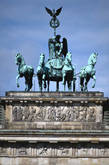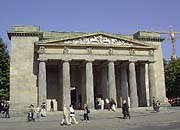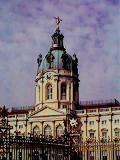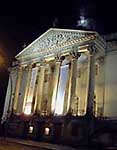 Sights Sights
 Medieval Remnants Medieval Remnants
 Prussian Glory Prussian Glory
 Nation to Republic Nation to Republic
 Nazi Germany Nazi Germany
 Divided City Divided City
 Modern Capital Modern Capital
 Tours Tours

|
Brandenburg Gate
(Brandenburger Tor)
map:
 What a wonderful feeling it is to walk through the Brandenburg Gate - the ultimate symbol of Berlin and of German reunification. Completed in 1791, its purpose was to serve as the main entrance to the city and to mark the beginning of Unter den Linden. The design is based on the propylea of the Acropolis in Athens and perched on top is a copy of Johann Gottfried Schadow´s copper sculpture, Quadriga. The sculpture has had a most turbulent history, completed and installed in 1791, it was captured and removed by the triumphant Napoleonic army when it entered Berlin in 1806. It was returned 8 years later when Napoleon was defeated and sat atop the Gate until it was destroyed during the course of WWII. The building of the Berlin Wall left the Gate in the no-mans-land just on the Eastern side of the city where it remained inaccessible to tourists and traffic until its reopening in December 1989. What a wonderful feeling it is to walk through the Brandenburg Gate - the ultimate symbol of Berlin and of German reunification. Completed in 1791, its purpose was to serve as the main entrance to the city and to mark the beginning of Unter den Linden. The design is based on the propylea of the Acropolis in Athens and perched on top is a copy of Johann Gottfried Schadow´s copper sculpture, Quadriga. The sculpture has had a most turbulent history, completed and installed in 1791, it was captured and removed by the triumphant Napoleonic army when it entered Berlin in 1806. It was returned 8 years later when Napoleon was defeated and sat atop the Gate until it was destroyed during the course of WWII. The building of the Berlin Wall left the Gate in the no-mans-land just on the Eastern side of the city where it remained inaccessible to tourists and traffic until its reopening in December 1989.
|
Victory Column
(Siegessäule)
Straße der 17.Juni am Großen Stern , 10785 Berlin - Tiergarten | Tel: 391 2961, Fax: no fax | S-Bahn Tiergarten, Bus 100 | Times: Mon 1:00 - 18:00, Tue - Sun 9:00 - 18:00 (closed when ice or snow on ground) | Admission: € 2; Concessions € 1
map:
 Erected at the request of Kaiser Wilhelm to commemorate the Prussian victories over France, Austria and Denmark, the huge gold-covered statue of the goddess of victory stands 69 metres high. She originally stood in front of the Reichstag from 1873, which was unfortunately inconvenient for Hitler's mass rallies. As a result, she was uprooted in 1939 and transported to her current spot overlooking the Tiergarten. The winged figure atop the column is Victoria Borussia, the Goddess of Victory. On a nice day it´s worth the thigh-busting 285-step hike to the top where you will be rewarded with a wonderful view of the Tiergarten and the rest of Berlin. All that is lacking is a roof-top cafe providing refreshment for the weary steppers. Erected at the request of Kaiser Wilhelm to commemorate the Prussian victories over France, Austria and Denmark, the huge gold-covered statue of the goddess of victory stands 69 metres high. She originally stood in front of the Reichstag from 1873, which was unfortunately inconvenient for Hitler's mass rallies. As a result, she was uprooted in 1939 and transported to her current spot overlooking the Tiergarten. The winged figure atop the column is Victoria Borussia, the Goddess of Victory. On a nice day it´s worth the thigh-busting 285-step hike to the top where you will be rewarded with a wonderful view of the Tiergarten and the rest of Berlin. All that is lacking is a roof-top cafe providing refreshment for the weary steppers.
|
Bebel Platz
Unter den Linden , Berlin - Mitte | Bus 100 |
map:
Formerly known as Opernplatz, this square opposite Humboldt University was the brainchild of Friedrich II and architect Georg Wenzeslaus and was to be the Forum Fridericianum, enclosed by a city palace, an academy and an opera house. Due to the obvious temptation of war, Friedrich found himself side-tracked and didn't get round to finishing the job, only managing to build the opera house (Deutsche Staatsoper ). The square made a name for itself on 10th May, 1933 when the Nazis held their first official book burning there, incinerating works of authors who were on the anti-Nazi "index". This event is remembered by the artwork in the centre of the square - a glass panel through which can be seen a room lined with empty, white bookshelves. If you step back a couple of metres, the impressive facades of the Humboldt University, Deutsche Staatsoper, and St Hedwig's Cathedral are reflected in the glass - a symbol of the oppression of free speech in this historic place of learning, culture and religion. The square was re-named in 1947 after the leader of the Social Democrats.
|
Neue Wache - Mahnmal
Unter den Linden 5, 10178 Berlin - Mitte | Bus 100 | Price: Free. | Times: Open daily.
map:
 From its completion in 1818 until the demise of the monarchy in 1918, the Neue Wache, built by Schinkel for Friedrich Wilhelm III, actually was the Royal Guardhouse. It stood, from 1931, in remembrance of the fallen of WW1 until the Nazis reinvented it as a memorial to all heroes Nazi. The concept was, understandably, altered by the GDR who, in 1957, had it standing for all the dead of both wars but especially the second, dedicating the Neo-classical Roman style Guardhouse as a "Memorial to the Victims of Fascism and Militarism". Goose-stepping guards were put in place and an "eternal" flame was lit but sadly the wind picked up in 1989 and the building's contract and job description were, once again, put through the shredder. Just about due for its pension, the guardhouse now serves as a "Central Memorial of the Federal Republic of Germany" entombing the bodies of an unknown soldier, a resistance fighter and a concentration-camp victim and housing the Käthe Kollwitz sculpture, Mother and her Dead Son. Having always been a good barometer for the city's political and social environment, there must always be the fear that it will see out its days as an ice-cream stall. From its completion in 1818 until the demise of the monarchy in 1918, the Neue Wache, built by Schinkel for Friedrich Wilhelm III, actually was the Royal Guardhouse. It stood, from 1931, in remembrance of the fallen of WW1 until the Nazis reinvented it as a memorial to all heroes Nazi. The concept was, understandably, altered by the GDR who, in 1957, had it standing for all the dead of both wars but especially the second, dedicating the Neo-classical Roman style Guardhouse as a "Memorial to the Victims of Fascism and Militarism". Goose-stepping guards were put in place and an "eternal" flame was lit but sadly the wind picked up in 1989 and the building's contract and job description were, once again, put through the shredder. Just about due for its pension, the guardhouse now serves as a "Central Memorial of the Federal Republic of Germany" entombing the bodies of an unknown soldier, a resistance fighter and a concentration-camp victim and housing the Käthe Kollwitz sculpture, Mother and her Dead Son. Having always been a good barometer for the city's political and social environment, there must always be the fear that it will see out its days as an ice-cream stall.
|
Schloß Charlottenburg
Luisenplatz , 14059 Berlin - Charlottenburg | Tel: 32 09 11, Fax: no fax | U2 Sophie-Charlottenplatz/U7 Richard-Wagner-Platz |
 Berlin's own inferior copy of Versailles was built for the reigning Hohenzollern princes (later kings) from 1695 to the 1800s. Nice enough if you're into Baroque architecture, otherwise a bit much of the same. The palace suffered heavy damage from Allied bombing in 1943, so what you see today is mostly a 1960s reproduction. The rooms in the central wing can be visited, but only by joining the tour in German - printed information in English is available at the entrance. The palace garden complex is one of the most beautifully laid out parks in Berlin - perfect for a picnic on a summer's day. Click here for more information on the buildings dotted around the gardens. If the weather is ugly, Schloß Charlottenburg is still worth a visit for the museums contained within its walls and nearby. The Museum for Primeval and Early History occupies the west wing, and across the road are the Egyptian Museum and the Berggruen Collection ("Picasso and his time"). The Romantic Gallery gives a good impression of the interior of the palace, without the unnecessary commentary in German. Berlin's own inferior copy of Versailles was built for the reigning Hohenzollern princes (later kings) from 1695 to the 1800s. Nice enough if you're into Baroque architecture, otherwise a bit much of the same. The palace suffered heavy damage from Allied bombing in 1943, so what you see today is mostly a 1960s reproduction. The rooms in the central wing can be visited, but only by joining the tour in German - printed information in English is available at the entrance. The palace garden complex is one of the most beautifully laid out parks in Berlin - perfect for a picnic on a summer's day. Click here for more information on the buildings dotted around the gardens. If the weather is ugly, Schloß Charlottenburg is still worth a visit for the museums contained within its walls and nearby. The Museum for Primeval and Early History occupies the west wing, and across the road are the Egyptian Museum and the Berggruen Collection ("Picasso and his time"). The Romantic Gallery gives a good impression of the interior of the palace, without the unnecessary commentary in German.
|
German State Opera - Deutsche Staatsoper
www.staatsoper-berlin.org
Unter den Linden 5-7, 10117 Berlin - Mitte | Tel: 20 35 45 55 , Fax: no fax | U6 Französische Str., Bus 100 | Times: Mon-Sat 10:00-20:00, Sun 14:00-20:00 | Tickets: € 13-120 | Cards: AmEx, Visa, MC.
map:
Making up the eastern edge of Bebelplatz is the Deutsche Staatsoper (German State Opera). Designed by Georg Wenzeslaus von Knobelsdorff in the style of a Greek temple and built in 1743 it was the first major victim of WWII bombing when on the night of 9-10th April 1941 it was consumed by flames. Restored by the Nazis and ready for its bicentenary bash in 1943, it was flattened properly on 3rd February 1945 only to spring back to life in 1955, rebuilt according to the original drawings, allowing for some alteration and enlargement. Still faithful to Knobelsdorff's original design is the gabled portico supported by six Corinthian columns. The inscription "Fridericus Rex Apolloni et Musis" refers to Friederich's dedication of the building as a temple to Apollo and the Muses. Performances continue to attract large audiences.
|

 top of page top of page
 ©
1999-2011 Berlin Information Group ©
1999-2011 Berlin Information Group anything missing or wrong? anything missing or wrong?
|

|

